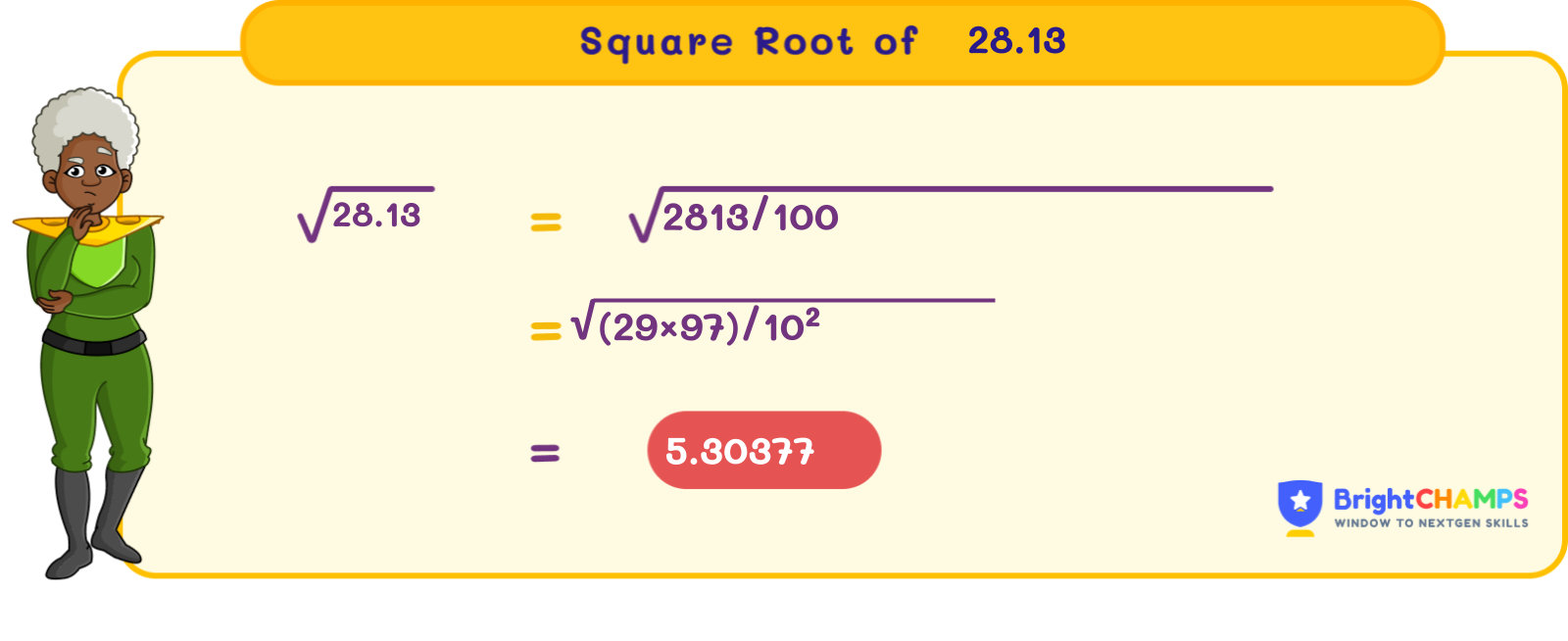![]() Table Of Contents
Table Of Contents

 100 Learners
100 LearnersLast updated on April 8th, 2025

Square Root of 28.13

If a number is multiplied by itself, the result is a square. The inverse of the square is a square root. The square root is used in fields such as engineering, finance, etc. Here, we will discuss the square root of 28.13.
What is the Square Root of 28.13?
The square root is the inverse of the square of a number. 28.13 is not a perfect square. The square root of 28.13 is expressed in both radical and exponential form. In the radical form, it is expressed as √28.13, whereas (28.13)^(1/2) is its exponential form. √28.13 ≈ 5.303, which is an irrational number because it cannot be expressed in the form of p/q, where p and q are integers and q ≠ 0.
Finding the Square Root of 28.13
The prime factorization method is used for perfect square numbers. However, the prime factorization method is not applicable for non-perfect square numbers where the long-division method and approximation method are used. Let us now learn the following methods:
- Prime factorization method
- Long division method
- Approximation method
Square Root of 28.13 by Prime Factorization Method
The product of prime factors is the prime factorization of a number. However, since 28.13 is not an integer, it cannot be expressed in terms of prime factors. Therefore, the prime factorization method is not applicable in this case.
Square Root of 28.13 by Long Division Method
The long division method is particularly used for non-perfect square numbers. In this method, we can estimate the square root by performing a series of divisions:
Step 1: Start by grouping the digits from right to left. For 28.13, treat it as 28.1300 for ease of calculation.
Step 2: Find the largest number whose square is less than or equal to 28. The number is 5, since 5 × 5 = 25. The remainder is 28 - 25 = 3.
Step 3: Bring down the next pair of digits (13) to make the dividend 313.
Step 4: Double the quotient (5) and find a new digit (n) such that 10n × n ≤ 313. The suitable digit is 3, since 103 × 3 = 309. The remainder is 313 - 309 = 4.
Step 5: Bring down the next pair of digits (00) to make the dividend 400.
Step 6: Double the current quotient (53) to get 106 and find n such that 106n × n ≤ 400, which is 3, since 1063 × 3 = 318. The remainder is 400 - 318 = 82.
Step 7: The quotient now reads 5.303.
Square Root of 28.13 by Approximation Method
The approximation method is another method for finding square roots, providing a quick way to estimate the square root of a given number.
Step 1: Identify the closest perfect squares around 28.13. The closest perfect squares are 25 (5²) and 36 (6²).
Step 2: Since 28.13 is closer to 25 than to 36, the square root of 28.13 will be slightly more than 5.
Step 3: Use interpolation to approximate: (28.13 - 25) / (36 - 25) ≈ (3.13 / 11) ≈ 0.284
Step 4: Add 0.284 to 5, resulting in approximately 5.284.

Common Mistakes and How to Avoid Them in the Square Root of 28.13

Square Root of 28.13 Examples

Problem 1
Can you help Max find the area of a square box if its side length is given as √28.13?

Explanation

Problem 2
A square-shaped plot measures 28.13 square meters. What will be the side length of this square plot?

Explanation

Problem 3
Calculate √28.13 × 4.

Explanation

Problem 4
What will be the square root of (20 + 8.13)?

Explanation

Problem 5
Find the perimeter of a square if its side length is √28.13 meters.

Explanation


FAQ on Square Root of 28.13
1.What is √28.13 in its simplest form?
2.What are the factors of 28.13?
3.Calculate the square of 28.13.
4.Is 28.13 a prime number?
5.Is 28.13 divisible by any integers?
Important Glossaries for the Square Root of 28.13
- Square root: A square root is the inverse of a square. For example, 5² = 25, and the inverse of the square is the square root, √25 = 5.
- Irrational number: An irrational number cannot be written as a simple fraction (p/q) where p and q are integers and q ≠ 0.
- Principal square root: The principal square root refers to the positive square root of a number.
- Long division method: A systematic method to find the square root of non-perfect squares, involving a series of division steps.
- Approximation method: A method used to estimate the square root of non-perfect squares by identifying nearby perfect squares and interpolating.
Explore More algebra
 Previous to Square Root of 28.13
Previous to Square Root of 28.13


Jaskaran Singh Saluja
About the Author
Jaskaran Singh Saluja is a math wizard with nearly three years of experience as a math teacher. His expertise is in algebra, so he can make algebra classes interesting by turning tricky equations into simple puzzles.

Fun Fact
: He loves to play the quiz with kids through algebra to make kids love it.




